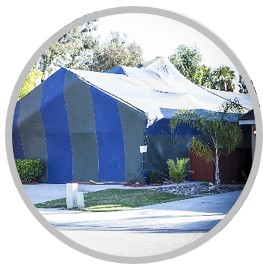Investigation Spotlight: Fumigation Tenting for Pests
 Problem
Problem
Every year, thousands of homes are fumigated for termites or other pests in California. Fumigation tenting or “whole house fumigation” is done by Structural Pest Control Operators (SPCOs).
This fumigation method uses a toxic gas called sulfuryl fluoride to kill bed bugs, termites, and other structure-infesting pests. This chemical has no smell, but can irritate your nose, eyes, throat, and lungs. At high enough levels, it can cause nausea, vomiting, seizures, or even death. In addition, another toxic chemical, chloropicrin, is used as a “warning” agent. Chloropicrin can cause burning in the eyes, nose, throat, and lungs, which “warns” you that a harmful chemical is present.
After fumigation, the SPCO takes measurements in the home to check that the toxic chemicals are below the required levels before allowing people to re-enter their homes. However, people can be exposed to these harmful chemicals even after the SPCO has certified a building to be safe.
Investigation
In 2021, the California Department of Public Health (CDPH) evaluated 86 illnesses related to fumigation tenting reported by the CA Department of Pesticide Regulation and the CA Poison Control System between 2003 and 2017. CDPH learned that most of the illnesses occurred after the house or building was cleared for re-entry.
CDPH's evaluation of the problem revealed that during fumigation tenting residual sulfuryl fluoride can get trapped in empty spaces such as wall sockets, crawl spaces, cabinets, and spaces in air mattresses.
Outcomes and impact
CDPH prepared a factsheet called Fumigation Tenting for Pests - How to Protect Yourself (pdf). This factsheet includes the investigation findings and recommendations for reducing exposures to sulfuryl fluoride.
Resources
CDPH factsheet: